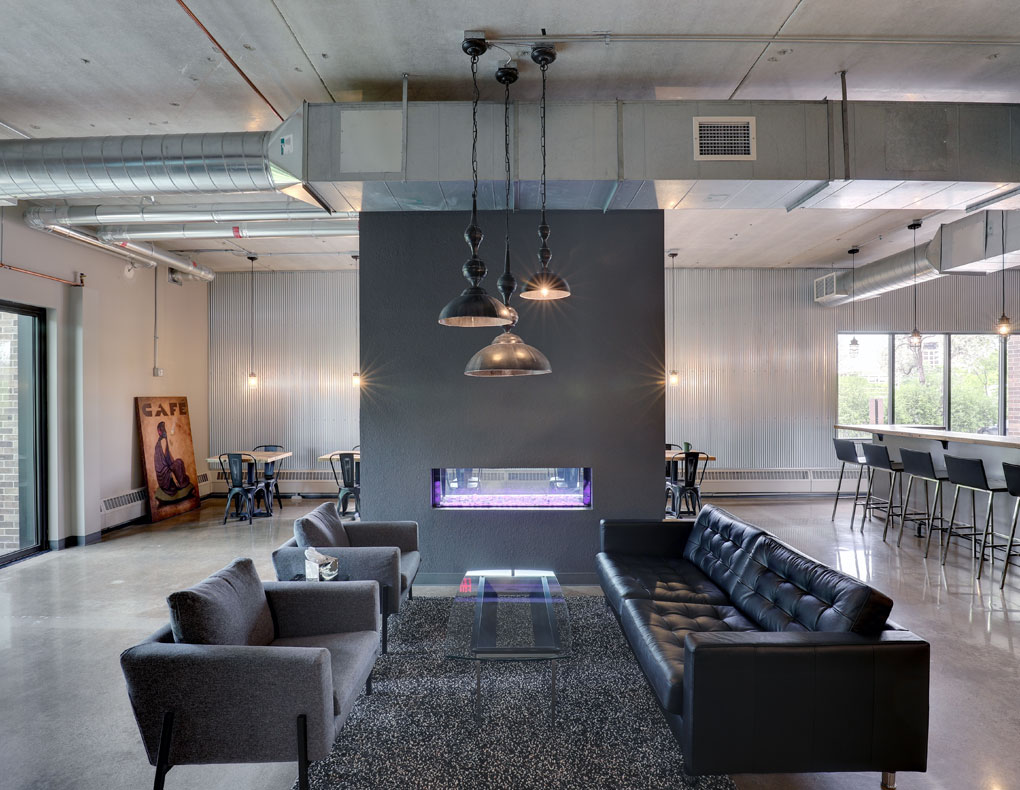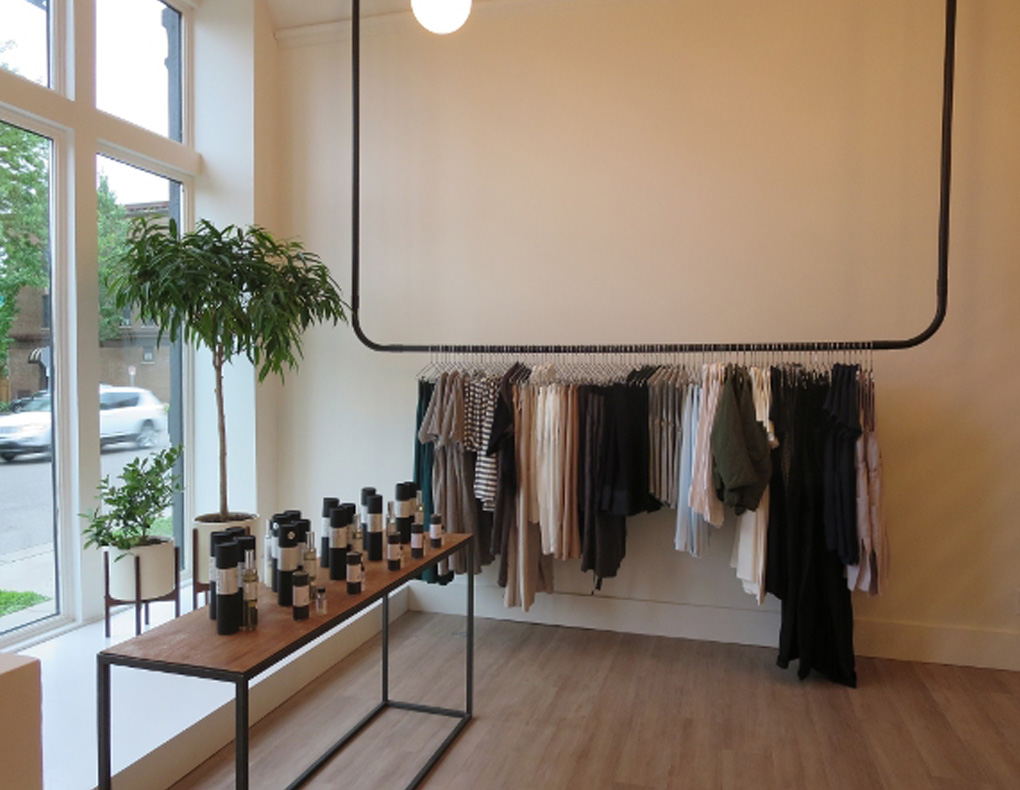Why does walking into most commercial interior design projects still feel like stepping back in time?
Stark white walls, rigid cubicles, and that peculiar shade of corporate gray that seems designed to drain joy from the human soul – that’s what I’m thinking of.
Or a storefront that plunges you into the kind of unflattering fluorescent lighting that any clothes try-on is going to threaten people’s self-esteem.
And from what I’ve seen, most businesses are still operating in spaces that actively work against them.
Meanwhile, talent is sticking in much more Instagram-worthy offices – ones that don’t feel more like a detention center than a creative hub.
Companies can spend considerable money on a rebrand – a new logo, new messaging, new everything – except the one thing clients and employees experience every single day.
Their space.
If you’re thinking about how to ensure your employees love their space as much as they love their work – and the two go hand-in-hand – then let’s dive into the importance of an ergonomic, inviting, and well-designed office or retail space.

The Billion Dollar Wake-Up Call
But here’s what those numbers don’t capture at first brush:
Commercial interior design accounted for 54.99% of the market in the last few years, and companies aren’t just updating their spaces anymore.
They’re completely reimagining what commercial interior design means in an era where your office competes with every employee’s perfectly curated home setup – their ideal lighting, their favorite coffee, their rescue dog curled at their feet.
We see this change take place almost daily at Studio M Architects.
Working with businesses from Minneapolis to Phoenix, the pattern reveals itself like morning light through old warehouse windows:
Commercial interior design has become the secret weapon for companies that actually want to thrive, not just survive.
The new reality? Your commercial interior design either elevates your business or slows it right down.
When Beige Became the Enemy of Progress
Remember when commercial interior design meant choosing between taupe and ecru?
When “bold” meant adding a single accent wall in a slightly darker shade of beige?
Those days are gone, and thank goodness for that!
According to recent research, 63% of consumers now prefer minimalist designs.
But minimalism in 2025 looks nothing like the sterile environments we’ve been trapped in for decades.
Today’s commercial interior design embraces what I call “intentional minimalism” – spaces that breathe like a yoga flow, that feel clean yet warm, simple yet impossibly sophisticated.
The shift happened when we finally admitted, collectively, that commercial interior design isn’t supposed to be all about following rules handed down from some corporate design deity.
It works best when geared toward creating experiences that linger in memory – that change how people feel about coming to work, that soften Monday morning dread.
Think about the last commercial interior design project that genuinely impressed you.
I’m betting it wasn’t the one with perfect symmetry and matching everything.
It was the space that surprised you, that made you want to explore its corners and hidden nooks, that felt like somewhere specific rather than anywhere generic.
That doesn’t mean beige is out, of course!
But it means swapping a cold, artificial interior for something warmer and more inviting – one that beckons you in.

The Biophilic Revolution
Let’s talk about the tree growing through the conference room.
But commercial interior design that truly embraces nature goes beyond dropping a few succulents on desks and calling it green.
Real biophilic commercial interior design changes the very air you breathe.
We recently completed a project where an entire wall became a living, breathing ecosystem – moss and ferns and trailing vines creating patterns that shift with the seasons.
Not for show, though it’s undeniably beautiful, but for function.
The plants naturally filter air, absorb sound like a forest floor, and create distinct zones without building a single wall.
This is an example of commercial interior design doing what it should: creating possibilities and solving problems in one fell swoop.
Color Psychology Isn’t So Woo-Woo After All
Color changes everything about how we feel, think, and behave.
I really do believe this – because not only are companies following the science and using color psychology to create work zones but it’s also something I’ve seen through our work at Studio M.
Calming blues for deep focus areas, energetic oranges for collaboration spaces, grounding greens for restoration zones.
But it’s tricky to do a good job when you pick colors from a catalog instead of from culture, from swatches instead of stories.
Your brand has colors, yes.
But those colours don’t always look so good on a wall.
When commercial interior design ignores these deeper connections, you get spaces that feel generic, disconnected, hollow – like a beautifully designed nowhere.
We recently tackled commercial interior design for a Scottsdale startup.
Instead of the expected tech-bro aesthetic of black and neon, we pulled colors from the surrounding desert – warm terracottas that echo red rocks at sunset, sage greens that mirror desert plants after rain, dusty purples from the shadows of saguaro cacti.
The space immediately felt rooted, authentic, theirs.
That’s the difference between commercial interior design that merely decorates and commercial interior design that truly communicates.
Wellness Trends in the Walls
Employee wellness is at the heart of office décor trends in 2025.
But wellness in commercial interior design means so much more than adding a yoga room that becomes a storage closet within six months.
Real wellness-focused commercial interior design addresses the full spectrum of human needs, acknowledging that we bring our whole selves to work, not just our professional personas.
Physical wellness through ergonomic furniture that adapts to bodies, not the other way around, and movement-encouraging layouts that make the stairs more appealing than the elevator.
Mental wellness via quiet zones that feel like sanctuaries and restorative spaces that reset the nervous system.
Social wellness with areas designed for genuine connection, not forced “fun.”
Environmental wellness using materials that don’t slowly poison us with off-gassing chemicals.
We just finished commercial interior design for an Eden Prairie company where every employee has access to height-adjustable desks, circadian lighting that shifts with the day, and what they call a “wellness concierge.”
Essentially, their commercial interior design actively promotes health throughout the day, nudging people in the right direction.
They’ve since reported that productivity is up significantly.
But more importantly, people actually want to be there.
Much more often, they’re choosing the office over home, not because they have to, but because the space makes them feel better and work better.
Making a Hospitable Space

Modern workplaces are increasingly incorporating hospitality-inspired amenities.
But copying hotel lobbies isn’t commercial interior design, and the real lesson from hospitality is this:
Orchestrating experiences – the discovery that sparks delight in unexpected corners, the retreat that restores energy when the world becomes too much.
We learned this working on many different restaurant designs where every square foot has a job – every view, every surface.
But it’s a mentality that applies to just about any business – restaurants, stores, office spaces.
Apply this thinking to commercial interior design, and suddenly your space isn’t just functional but dynamic.
Not to cultivate artificial drama but genuine moments of beauty, surprise, and connection.
The Cultural Component
Commercial interior design often forgets the most important element: culture.
But it’s possible to push this further in commercial interior design – much further.
That Galveston project?
We didn’t just acknowledge the coastal location with some nautical rope and a ship’s wheel.
We celebrated and honored it in whatever creative ways we thought would work best:
We used weathered wood salvaged from old piers, each plank holding decades of storms and sunshine.
We incorporated colors pulled not from paint chips but from sunrise over the Gulf, that particular shade of pink-orange that locals know means good weather coming.
Commercial interior design that embraces its place becomes part of the community’s story.
The Decision Point: Evolution or Extinction
There’s no doubt that commercial interior design shapes behavior, builds culture, and determines employee wellbeing and business success.
The companies thriving in 2025 get this in their bones.
Their commercial interior design doesn’t just house their business but truly embodies it, amplifies it, evolves with it like a living thing.
So ask the question: Is your commercial interior design working for you or against you?
Bringing Your Interior Vision to Life
Walk into the right spaces, and you’ll feel it immediately – that electric sensation of possibility, that sense that important things happen here, that feeling of being simultaneously energized and at peace.
That’s not accident or luck so much as it’s intention made physical.
That’s commercial interior design doing what it was always meant to do.
The old model of commercial interior design – safe, sterile, same – is dying a slow but certain death.
What’s emerging from its ashes is something far more interesting: spaces that surprise and delight, that respond and adapt, that remember and learn.
Ready to revolutionize your commercial interior design?
At Studio M Architects, we’ve spent over 20 years transforming commercial interior design from obligation to opportunity, from expense to investment, from space to place.
Stop letting your space hold you back from becoming what you’re meant to be.
Contact us today for a consultation that will change how you think about commercial interior design forever.

Recent Comments